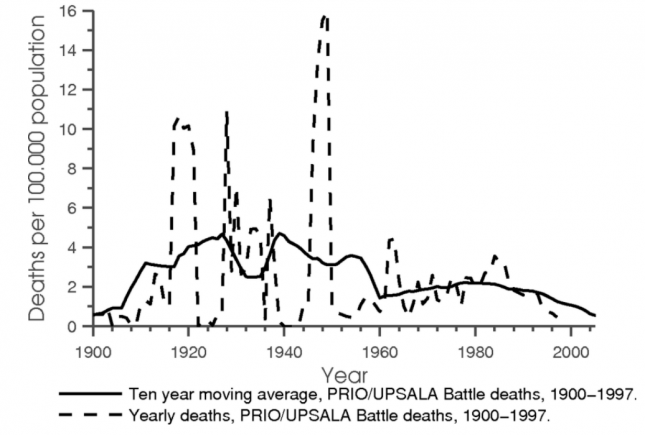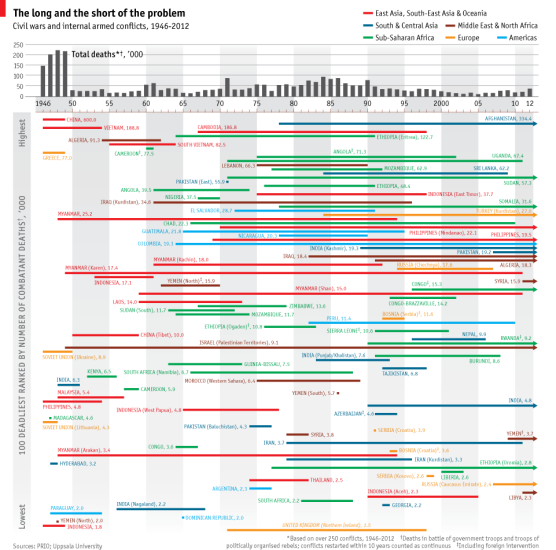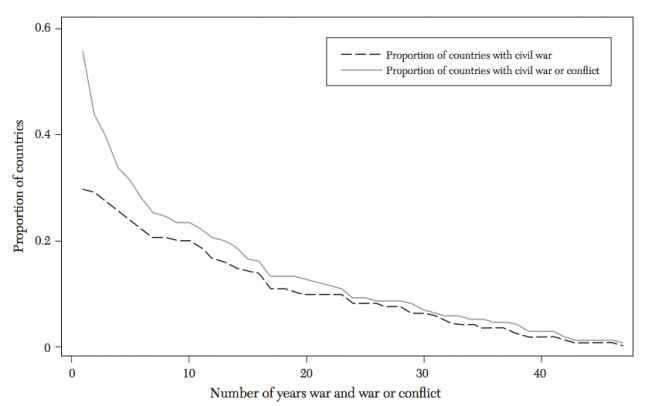Notice: This is only a preliminary collection of relevant material
The data and research currently presented here is a preliminary collection or relevant material. We will further develop our work on this topic in the future (to cover it in the same detail as for example our entry on World Population Growth).
If you have expertise in this area and would like to contribute, apply here to join us as a researcher.
All our charts on Civil Wars
Over the course of the 20th century, the deaths from civil wars (as defined by PRIO-UPSALA dataset) first spike at the end of the First World War, and flare up again in the interwar years as well as the end of the Second World War. The end of the WWI saw the collapse of the Ottoman, Austro-Hungarian, German and Russian Empires, as well as the beginning of the end of the remaining European powers. The collapse of the Russian Empire in 1917 led to the Russian Civil War and the deaths of millions of people. What is more, many modern conflicts in the Middle East (both civil and conventional wars) have their roots in the division of the Ottoman Empire.
The rising number and intensity of conflicts between the end of WWII and the collapse of the Berlin Wall (1945-89) is associated with the Cold War. The struggle for global superiority between the United States and the Soviet Union led both to engage in proxy wars with one another. Both the Korean War and Vietnam War began as civil wars but ended up drawing in resources from the US and Soviet Union. These two graphs show precisely how the number of civil wars increased from the end of the Second World War before peaking in the 1990s and the distribution of conflict lengths. During this peak, around a third of countries in Sub-Saharan Africa were engaged in civil war. James Fearon and David Laitin explain the peak in the 1990s as the result of the accumulation of protracted conflicts:2
The prevalence of internal war in the 1990s is mainly the result of an accumulation of protracted conflicts since the 1950s rather than a sudden change associated with a new, post-Cold War international system. Decolonization from the 1940s through the 1970s gave birth to a large number of financially, bureaucratically, and militarily weak states.
These two graphs show just how common internal wars are and the high degree of persistence in these conflicts. The coloured chart is from The Economist and displays a ranking of the 100 deadliest civil wars and internal conflicts since WWII. It neatly displays the variance of civil wars: many conflicts are relatively short-lived but some have lasted decades; the deadliest civil war had 600 combatant deaths per thousand while the lowest ranked conflict had only 1.5. The black and white line chart from Blattman and Miguel (2010) shows the distribution of the number of years countries experienced conflict between 1960 and 2006.4
They estimate that 20% of nations have experienced at least ten years of civil war.
Greed versus Grievance: the causes of civil war
One of the most influential studies on civil war is that by Collier and Hoeffler. They argue that the causes for such conflicts are primarily economic and not grievance based. This theory rejects the idea that civil wars are caused by ethnic, religious or other socio-demographic factors. Instead civil wars are the result of rational individualistic assessments of the costs and benefits of conflict as well as the likelihood of success. The economic gains from conflicts are often control of resources and political power.
Paul Collier and Anke Hoeffler tested this theory empirically using data from civil wars over the period 1960-99.7
They find that the opportunities model performs much better in predicting the onset of civil war compared with the grievance model, which they find adds little explanatory power. Their main findings are summarized below:
- Availability of finance: Primary commodity exports substantially increase the risk of conflict, and the authors interpret this as the effect of opportunities to extort. Diasporas also increase the risk of conflict renewal, which is interpreted to be the result of diaspora financing. This type of financing was a particular feature of the Sri Lankan Civil War where the Tamil Tigers received significant funding from the diaspora population.
- Opportunity cost of rebellion: Measures of opportunity cost such as male secondary education enrollment, per capita income and the growth rate all have significant conflict reduction effects. These variables collectively proxy the foregone earnings if individuals choose to rebel.
- Military advantage: Population dispersion increases the risk of conflict because it provides the rebels with military advantage.
- Population size: A large population increases the risk of conflict. The reason for this effect is left open to interpretation and may reflect increased opportunities or grievances.
- Grievances: Inequality, political rights, ethnic polarization and religious fractionalization were all insignificant variables in predicting conflict. They find that only ethnic dominance, where one ethnic group is the majority, increases the risk of conflict.
- Time: Time since the last conflict reduces the risk of new conflict, suggesting time can heal the wounds of civil war.
James Fearon and David Laitin agree with Collier and Hoeffler’s general analysis that economic factors are the main drivers of civil conflicts, but suggest that insurgency plays a large part.8
Fearon and Laitin define insurgency as “a technology of military conflict characterized by small, lightly armed bands practicing guerrilla warfare from rural base areas.” Fearon and Laitin characterize most civil conflicts as the result of weak and corrupt governments fighting insurgencies protected by difficult terrain (mountains, desert, jungle) and a sympathetic population. In many cases, these insurgencies are supported by foreign diasporas or sympathetic groups and the revenues generated from appropriated commodities.
The Correlates of War (COW) project produces the most comprehensive and widely used dataset on civil war. A basic requirement for classification is that: “intra-state war must… involve sustained combat, involving organized armed forces, resulting in a minimum of 1,000 battle-related combatant fatalities within a twelve month period.”
The classification of civil wars and intra-state conflicts is a delicate problem and the dataset differentiates between many different types of conflict:
- Civil wars involving the government of the state against a non-state entity
- Conflict to control the central government
- Disputes over local issues
- Regional internal wars involving the government of a regional subunit against a non-state entity
- Intercommunal wars involving a combat between/among two or more non-state entities within the state
When the government is involved as an entity in the conflict, it must either commit 1000 troops to the war or suffer 100 battle-related deaths. The threshold for non-state armed groups is lower at 100 armed personnel or 25 battle-related deaths. Full details on the classification rules can be found in Inter-state Wars (Version 4.0): Definitions and Variables by Meredith Reid Sarkees.
- Data: Intra-state conflict
- Geographical coverage: Global
- Time span: 1816-2007
- Available at: http://cow.dss.ucdavis.edu/data-sets/COW-war/intra-state-war-data-v4-0
- Data: Armed conflict
- Geographical coverage: Global
- Time span: 1946-Present
- Available at: https://www.prio.org/Data/
- Data: Major episodes of political violence
- Geographical coverage: Global
- Time span: 1946-Present
- Available at: http://www.systemicpeace.org/



